HMAS Adelaide History
Design work for the PERRY class ships started in the early 1970s.
These ships were originally conceived as a low-cost convoy escort (hence the original "PF" (Patrol Frigate) hull number for the prototype). In mid-1975, the PERRY class ships were re-classified as FFGs (guided Missile Frigates). The ships were completely developed by the US Navy and later awarded for construction to the two lowest bidding shipyards - Bath Iron Works and Todd. Construction went on in time and sometimes even ahead of schedule.
The first PERRY class ships were commissioned without the SQS-56 Sonar because production of the system started too late so that it was not yet available during the construction of the ships. Originally to be 75 in number, a total of 55 FFG 7 OLIVER HAZARD PERRY class ships were built, including 51 for the US Navy and four for the Royal Australian Navy. Australia subsequently built a further ship of this design at a very high cost.
Spain also built to this design and a modified design was built in Taiwan (the Cheng Kung Class).
Early in their operational lives, ships of the FFG 7 class, the ex HMAS Adelaide included, began to develop serious cracking in the superstructure, which extended from side-to-side and for approximately 70% of the length. These cracks were serious in that they could extend down into the hull portion of the ship and provided a way for water to flood important weapons system spaces.
Detailed inspections were made, analyses undertaken, and model-scale tests conducted. Fixes compatible with the entire class were developed and subsequently installed. Tests were conducted at sea and were found to be satisfactory; further fixes were then carried out on all ships of the FFG 7 class.
The PERRY class ships were produced in two variants, known as "short-hull" and "long-hull", with the latter variant being eight feet longer than the short-hull version. The long-hull ships [FFG 8, 28, 29, 32, 33, 36-61] carry the SH-60B LAMPS III helicopters, while the short-hull units carry the less-capable SH-2G.
The reason for the two variants was due to the late introduction of the SH-60B helicopters.
When the PERRY's were designed, LAMPS III was not yet tested and one did not know how the new helicopter would approach the ship for landing. Therefore, the first 26 ship in the PERRY class were completed in SH-2G configuration. When it became obvious that the SH-60B would not approach the ship sideward like the SH-2G but directly from astern, the remaining ships of the class were completed with an 8-feet long hull extension astern of the flight deck.
In late 1980, the first sea trials of an SH-60B aboard a PERRY class guided missile frigate took place aboard the previously modified USS McINERNEY (FFG 8).
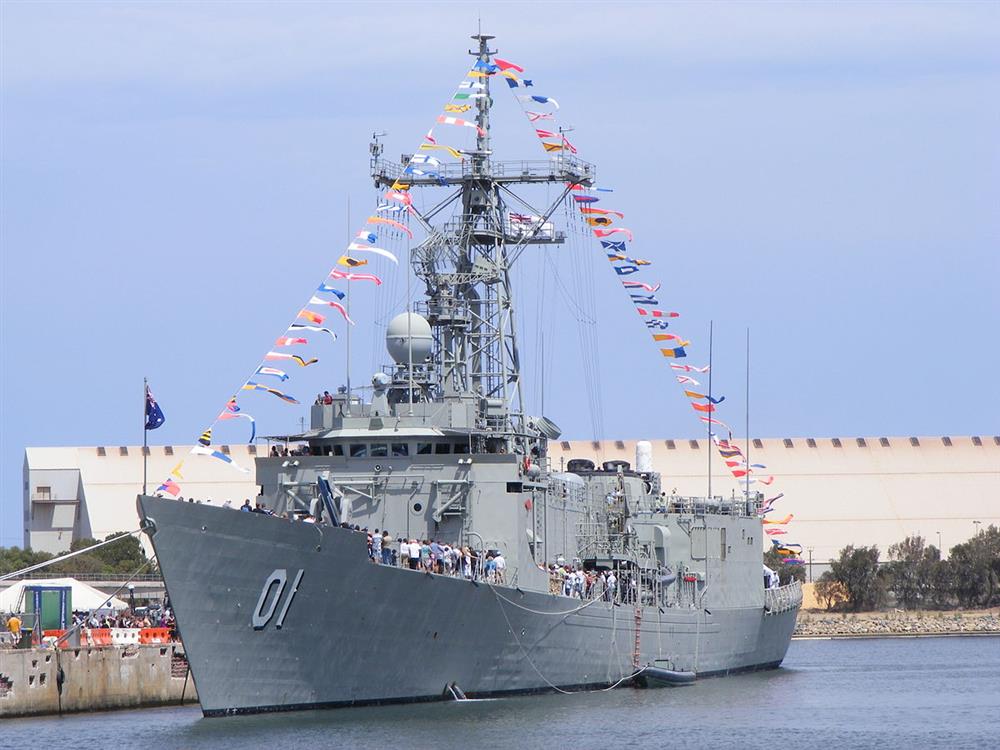
In 1978, a 1:1 SH-60B scale model was used for testing aboard USS OLIVER HAZARD PERRY (FFG 7). Although the ships were intended to operate the LAMPS III ASW helicopter, FFG 7-35, as completed, lacked the equipment necessary to handle them. Beginning with the FY79 ships (FFG 36 and later), helicopter support equipment was aboard on completion: fin stabilizers, RAST (Recovery Assist, Secure, and Traverse system - not fitted as completed until FFG 50), and other systems.
The RAST system installed aboard the ex HMAS Adelaide permitted helicopter launch and recovery with the ship rolling through 28 degrees and pitching 5 degrees. The equipment was first installed in MCINERNEY (FFG 8), which was reconstructed in 1981 at Bath Iron Works to act as LAMPS III/SH-60B Seahawk helicopter trials ship.
The Search for a Wreck
The ex HMAS Adelaide served the Australian Navy for more than 20 years and we wanted to ensure its future as a major tourist attraction on the Central Coast to be just as successful.
At 138.1 metres in length, the decommissioned frigate was scuttled off the NSW Central Coast on March 13th, 2011 to create an artificial reef. It took only one minute and thirty nine seconds for the Adelaide to slip below the surface and become one of the most popular dive wreck sites and newest artificial reef in Australia.
There is certainly a lot of ship to see. Just cruising around the outside of the artificial reef, the sheer size makes an awesome sight. Water temperatures range from 15C in winter to a summer high of 24 C. Visibility averages around 15 metres in Summer up to 40 metres or more is not uncommon during the cooler months.
The ex-HMAS Adelaide lies in approximately 35+m of water with the bow facing towards the open ocean. The top decks lie at 25 metres and the main deck is at 29 metres while the sand is at 35+ metres.
The ex HMAS Adelaide wreck has many deck levels that lends itself to multilevel diving which maximises your dive time. We highly recommend the use of dive computers and/or multi-level dive planning. To take advantage of this fact, ProDive offers hire gear with dive computers included.
ProDive have the exclusive moorings on the ex HMAS Adelaide wreck located on the main mast at 14 metres. Using this mooring you can perform a multi-level dive, ending with your safety stop at five metres. Makes finding the wreck a lot easier than descending to the sand at 34m and swimming to the wreck.
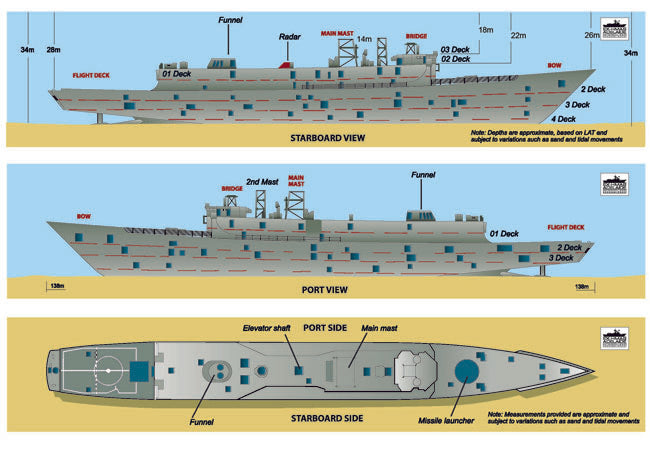
Diver access holes have been cut parallel to each other on either side of the hull so there are quite enough entry and exit points in all areas of the ship. Visibility at certain times of the year is quite poor, this should not adversely affect your dive as, inside the wreck very little sediment/silt has built up and this does not affect visibility greatly.
After special preparation to become an artificial reef, the ex HMAS Adelaide wreck is a relatively easy wreck to penetrate, we still recommend that only experienced divers penetrate the wreck.
Before the Adelaide could be scuttled off the coast, environmental and diver safety issues had to be implemented into the design phase- Bob Diaz as a member of this group, took great interest in this issue to ensure diver safety was paramount.
One of the biggest concerns was the removal of electrical cabling all over the vessel, held in cable trays that could have fallen down creating a dangerous entanglement for divers.
The ex HMAS Adelaide wreck had to be made diver safe but, remained interesting enough for divers of varyious levels and fun to explore. Bob had visited the vessel many times during its restructuring as a dive wreck/ artificial reef and after walking through the companion ways, climbing the many ladders and squeezing past machinery, was never concerned the wreck would become a dull or boring experience.
There are still challenges with lower light level areas, machinery, bulkheads and cupboards have come adrift in the scuttling and subsequent storm that followed the scuttling.- this all adds to the enjoyment of the dive.
“Remember that all access holes lead to the outside- Divers never need to backtrack to find an external opening”.We do however, strongly recommend that beginner divers and less experienced divers take extra precautions to further explore the ship. Why not take the next step and explore the HMAS Adelaide as a Deep or Wreck diver? The Adventure wreck and deep Dive can be attributed towards your specialty diver rating?
Can't wait to dive a specially created artificial reef namely the ex-HMAS Adelaide, book a dive with Pro Dive Central Coast today.
The Legal Battles
After a long and drawn out legal struggle to begin with, the ex HMAS Adelaide is now safely on the bottom of the Pacific Ocean off the NSW Central Coast is doing exactly as she was intended;-
- Attracting marine life to the newest artificial reef
- Becoming a place for scuba divers the world over to enjoy
- Attracting divers worldwide to a terrific tourism and economic asset for the NSW Central Coast.
The objections began when a group of residents from the seaside community of Avoca Beach suddenly and without prior (sic) warning discovered a large naval warship was to be sunk a short distance off “their” beach without "their" prior consent or "their" consultation.
This started an avalanche of controversy that lead to claims of nimbyism, false and misleading information designed to frighten and mislead Central coast residents and possibly, divide a community.
The biggest environmental problem was the removal of oil and hydraulic fluids, PCBs, Lead, Mercury and potential toxic materials. Whilst the ex-HMAS Adelaide had been specially prepared as a dive site and is relatively safe, however as with any other dive site hazards do still exist as can be present on any wreck dive.
To put a positive spin on the debacle caused by a few individuals, the following media releases from the No Ships group did more to advertise and market the Adelaide than we could have ever imagined!
The anti-ship group helped the Pro group to take the HMAS Adelaide to the world stage. We are forever grateful for their vain, ill informed, scurrillous and sometimes tedious efforts, that really did pay off for us, in the end.
Some of the Media releases from No Ship Action Group includedthe following gems, however some of thr articles are no longer available online.
- Warship threatens to erode Avoca Beach: further studies needed - October 20, 2010
- Tribunal rebuffs Government Warship appeal - October 12, 2010
- Abandon warship scuttling or do full environmental study - September 24, 2010
- Tribunal orders toxins off warship - September 16, 2010
- State Government happy to dump 28 tonnes of lead paint at Avoca Beach - July 8, 2010
- The Castle Battles the Warship [PDF] - July 4, 2010
- Don’t dump warship on whales: recycle [PDF] - June 29, 2010
- State Government Squanders Money on Warship Debacle [PDF] - March 27, 2010
- Warship Steals Five Metres of Beach [PDF] - March 16, 2010
- World Class Surfer Teaches Tony About the Sea [PDF] - March 16, 2010
- HMAS Adelaide threat to Avoca homes - Coasting Magazine 17–03–2010
- Scuttled ship would wreck bay: residents - Sydney Morning Herald 7
The attempt to frighten and mislead people was refuted in the tribunal. Headed by three Advocates who, unanimously agreed that the HMAS Adelaide artificial reef, would be a benefit to the community and a safe site for divers and residents alike.
The Final Journey
The ex HMAS Adelaide left Sydney harbour a little after 6 am on Monday 11th of April, 2011.
Her presence under Sydney Harbour bridge was a spectacular site and when she passed the Sydney Opera house on her journey the vision was intense.
She was escorted out of the harbour by a small spectator fleet on her final journey and eventual scuttling on the NSW Central Coast to begin a new life as an artificial reef.
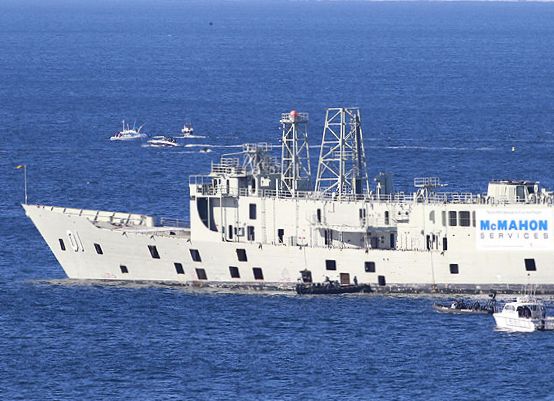
The ex-HMAS Adelaide had been stripped, cleaned and made dive ready. Over the next few days, diver access holes would be completed and the navies former warship the HMAS Adelaide II, would be scuttled to become an artificial reef.
Media attention was high and all Sydney channels took the opportunity to farewell the vessel and this vision was seen all around the world. I received calls from China, Scotland and America from friends and allies also a few- not so friendly, who watched the scuttling event on their local news stations, live on television.
Our Newest Reef
The ex HMAS Adelaide is the largest and most accessible former naval dive wreck scuttled as an "artificial dive reef" in the Southern Hemisphere. At 138.1 metres in length and over 15 metres wide- Four lower levels and three upper decks, this equates to a whole lot of ship to explore.
Although the ex-HMAS Adelaide is a very diverse and complex dive site, it is not too difficult to navigate if you take note of some of its distinctive features. In particular, the helicopter hangars, Operations room, Flinders Street, the missile launcher, torpedo magazine and bridge, are all useful areas to remember as landmarks for orientation to the vessel.
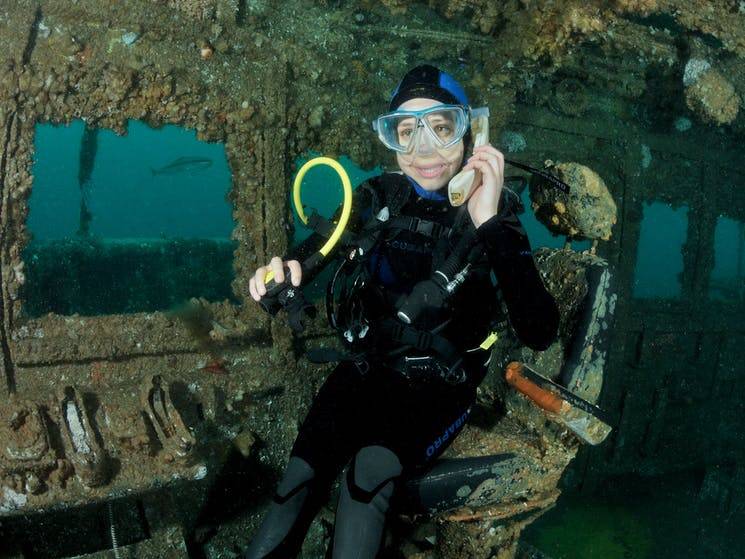
Scuba divers wishing to penetrate the wreck should be suitably qualified, prepared and carry all the necessary equipment including a light source to further explore the dimmer areas. Scuba divers planning to penetrate the wreck, should make at the minimum- one orientation dive outside the vessel, or follow an experienced Diver who some knowledge of the areas of interest and location of safe exits.
Remember at all times, this site has been designed with diver safety as paramount in all aspects.
Bob Diaz, a member of the two committees to ensure the Adelaide was made "Diver friendly" carefully noted and offered advice when asked and inspected the ship, many times over the deconstruction phase- The access holes cut in the hull easily allow two divers to swim side by side to exit the inner parts of the vessel. Whilst vertical accesses were cut in several areas of each deck to allow easy vertical access within the ship to decks above and below without the need to exit the ship.
ProDive has exclusive use of the main mast, mid-ship mooring. This is the best possible position to start your dive, as it makes for a very easy and relaxed dive plus gives you great orientation to the safety stop area on the mast. Making your descent down our mooring line onto the crossover line at five metres, you follow this line across to the mast at fourteen metres and then take a leisurely swim to the bow or stern. This allows for a relaxed dive that covers the whole wreck. No frantic rush swimming from one end to the other.
Environmental studies commissioned by the EPA confirm that the bio-diversity of the marine life that has already made the HMAS Adelaide home will only increase in size and number as the Adelaide is slowly taken over its intended marine inhabitants. Plus the numbers of animals making the Adelaide their home will only continue to increase as the years go by and the marine life becomes further accustomed to the area.
Book a dive and experience this awesome divesite for yourself.
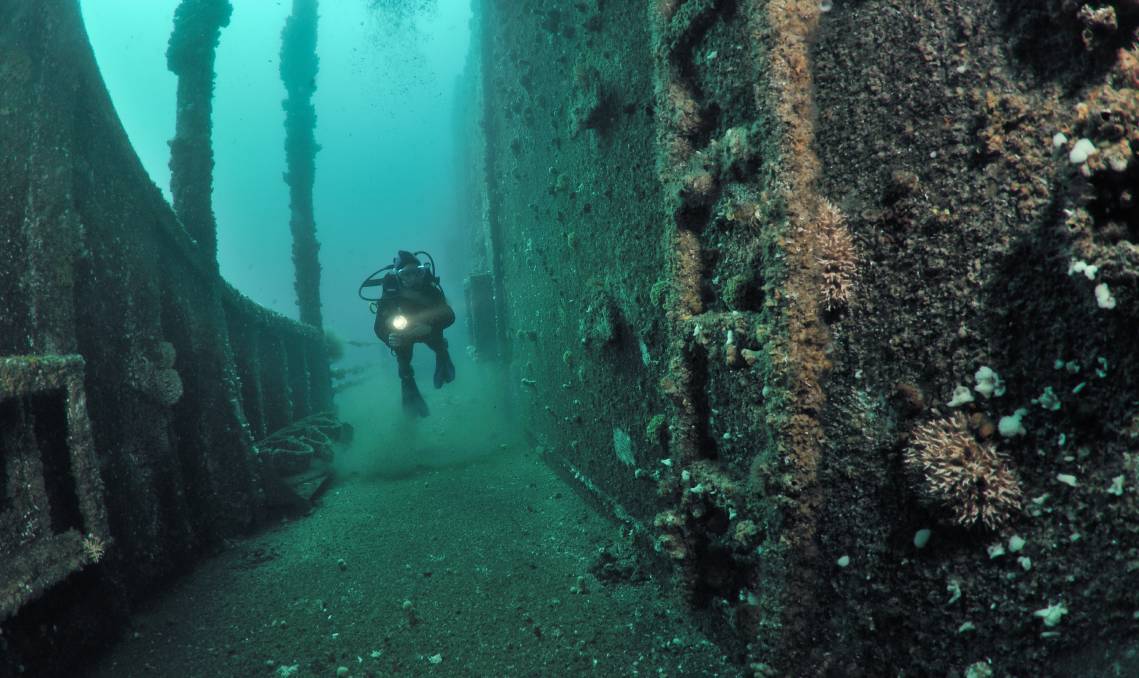
Frequently Asked Questions
The ex HMAS Adelaide was scuttled on April 13th, 2011.
March to September, during our Autumn or Winter. Expect calmer water with very little swell due to the Westerly Winds- Water temp is around 17 to 18 degrees. Some years we experience a few weeks with lower than normal water temperatures around 15 to 16 degrees in late June or early July. Visibility ranges up to 40 metres.
Around October, Spring and Summer the air and water temperatures begin to warm up, during Summer the afternoon north easterly winds occur and this can make diving the east coast a little uncomfortable after lunchtime. Visibility ranges from 15 to 30 metres.
Following severe storms, the local ocean water is obviously very dirty and the visibility around the wreck becomes very low, around two to four metres.
The ex HMAS Adelaide lies in 35 metres of water. The top of the mast is at 14 metres, Top deck is 25 metres, the main deck is 29 metres and the sand is 35 metres. You can access deeper inside the Adelaide to 39 metres.
Advanced Open water divers with a minimum of ten dives post course with two being in the last six months.
Yes, Pro Dive offer Refresher and Skills Update courses weekly.
Yes, suitably trained and qualified technical diver are offered, extended dive times. Please arrange when you book.
Yes, you can rent scuba gear.
Swarms of marine life now call the Adelaide home. You will see large Yellow Tail Kingfish, Bream, Trevally, inquisitive Mados, Silver Sweep swimming around the structure whilst Sergeant Bakers and several Moray eels have found refuges along with several Wobbegong sharks.
Several times a year the site is visited by a school of Jewfish with several Grey Nurse sharks dropping in, for a short break.
To fully explore the entire ship, you will need to do around 25 dives. The HMAS Adelaide has three top deck levels and four below deck levels. There is a junior Sailors cafe with several corridors leading to other parts of the ship. A galley, Sick Bay, gigantic gearbox, open Bridge as well as the forward and aft decks along with machinery spaces, open covered areas and helicopter hangars. You can always sit and watch the fish life that is constantly moving and evolving over time.
NO! The ex HMAS Adelaide lies a short five minute boat ride from Terrigal Haven, that would acquaint to a one or two hour swim.
At this point in time Night Dives are not available. Pro Dive Central Coast will organise night dives to suitably qualified divers as soon as time allows.
We have over 429 dive sites up and down the coast so check our dive calendar for dive sites. Group bookings to different sites are available every day of the week.
Some of our wreck sites include:
- Nerong at 43m
- Kiama at 45m
- Galava at 51m
Reef sites include:
- The Pinnacle 19 to 30m
- Entrance Bommie 10 to 30m
- First point 14 to 30m
- Too many others to list . . .
Certainly, simply click one of the buttons above or contact us at the shop on 02 4389 3483
